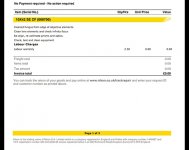Re.Post 15.
Fig. 1.3.
This was common in the 1980s in Aero Ektar 7 inch f/2.5 lenses made 1940 to 1945.
The coded serial numbers give the date of manufacture.
In fact it was difficult to find a pristine lens without this fault.
I think the large size of the groups was partly the problem, but the separation formed all over the lenses. It may be due to steep curves? Or just rushed wartime production. I suppose it could be that the heat for coating if applied after the groups were cemented, caused the cement faults to develop.
Yellow spot ones on the front bezel are Kodak coated. No spot are shadow factory coated.
These balsam faults will not have improved with time.
I don't think that it was due to the thorium elements as these were, from memory glasses 4 and 6 from the 7 glass lenses. The thorium elements were brownish. The speed of the lens probably dropped from f/2.5 to f/3.5 or f/4.(Or T/3.5 to T/4).
The lenses were hard coated.
From memory, and it is almost 40 years ago, the large Aero Ektars, 3 or 4 12 inch f/2.5, single 24 inch f/6 and single 8 inch f/1.5 that I had didn't have this problem, although I could be mistaken.
I never saw a 6 inch f/2.5 or 48 inch f/6.3 Aero Ektar in England.
I have unfortunately seen hundreds of lenses and binoculars with various types of fungus.
I think that indeed the 10x42 SE here has the start of moisture effects getting past the edge of the objective and probably into the balsam. The edge of the objective may also show signs.
If it was my binocular, I would try to inspect every lens and prism surface for signs of haze, moisture or fungus.
It may be wise of Nikon if they just offer a replacement waterproof binocular.
With old British lenses from the mid 1800s onwards I rarely saw fungus. And fungus from uncoated lenses using simple glasses often simply wiped off.
When more exotic glass types came into use, fungus became a problem.
There is also devitrification of glass, but usually from old glass say one hundred years old.
The 1800s Northumberland refractor became unusable. Jim Hysom made a nice 12 inch f/20 approx. new objective using selected glass. The telescope is now used regularly.
Why stained glass windows last centuries, I don't know. Probably the metals in the glass?
Fig. 1.3.
This was common in the 1980s in Aero Ektar 7 inch f/2.5 lenses made 1940 to 1945.
The coded serial numbers give the date of manufacture.
In fact it was difficult to find a pristine lens without this fault.
I think the large size of the groups was partly the problem, but the separation formed all over the lenses. It may be due to steep curves? Or just rushed wartime production. I suppose it could be that the heat for coating if applied after the groups were cemented, caused the cement faults to develop.
Yellow spot ones on the front bezel are Kodak coated. No spot are shadow factory coated.
These balsam faults will not have improved with time.
I don't think that it was due to the thorium elements as these were, from memory glasses 4 and 6 from the 7 glass lenses. The thorium elements were brownish. The speed of the lens probably dropped from f/2.5 to f/3.5 or f/4.(Or T/3.5 to T/4).
The lenses were hard coated.
From memory, and it is almost 40 years ago, the large Aero Ektars, 3 or 4 12 inch f/2.5, single 24 inch f/6 and single 8 inch f/1.5 that I had didn't have this problem, although I could be mistaken.
I never saw a 6 inch f/2.5 or 48 inch f/6.3 Aero Ektar in England.
I have unfortunately seen hundreds of lenses and binoculars with various types of fungus.
I think that indeed the 10x42 SE here has the start of moisture effects getting past the edge of the objective and probably into the balsam. The edge of the objective may also show signs.
If it was my binocular, I would try to inspect every lens and prism surface for signs of haze, moisture or fungus.
It may be wise of Nikon if they just offer a replacement waterproof binocular.
With old British lenses from the mid 1800s onwards I rarely saw fungus. And fungus from uncoated lenses using simple glasses often simply wiped off.
When more exotic glass types came into use, fungus became a problem.
There is also devitrification of glass, but usually from old glass say one hundred years old.
The 1800s Northumberland refractor became unusable. Jim Hysom made a nice 12 inch f/20 approx. new objective using selected glass. The telescope is now used regularly.
Why stained glass windows last centuries, I don't know. Probably the metals in the glass?




